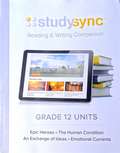- Table View
- List View
StudySync [Grade 6], Reading & Writing Companion [Unit 3]: Facing Challenges
by BookheadEd Learning LlcNIMAC-sourced textbook
StudySync [Grade 6], Reading & Writing Companion [Unit 4]: Our Heroes
by BookheadEd LearningNIMAC-sourced textbook
StudySync [Grade 7], Reading & Writing Companion [Unit 1]: Conflicts and Clashes
by BookheadEd LearningNIMAC-sourced textbook
StudySync [Grade 7], Reading & Writing Companion [Unit 1]: In Pursuit
by BookheadEd LearningNIMAC-sourced textbook
StudySync [Grade 7], Reading & Writing Companion [Unit 2]: High and Lows
by BookheadEd LearningNIMAC-sourced textbook
StudySync [Grade 7], Reading & Writing Companion [Unit 2]: The Powers that Be
by BookheadEd LearningNIMAC-sourced textbook
StudySync [Grade 7], Reading & Writing Companion [Unit 3]: Chasing the Impossible
by BookheadEd LearningNIMAC-sourced textbook
StudySync [Grade 7], Reading & Writing Companion [Unit 3]: Justice Served
by BookheadEd LearningNIMAC-sourced textbook
StudySync [Grade 7], Reading & Writing Companion [Unit 4]: Getting Along
by BookheadEd LearningNIMAC-sourced textbook
StudySync [Grade 7], Reading & Writing Companion [Unit 4]: Moment of Truth
by BookheadEd LearningNIMAC-sourced textbook
StudySync [Grade 7], Reading & Writing Companion [Unit 5]: Test of Time
by BookheadEd LearningNIMAC-sourced textbook
StudySync [Grade 7], Reading & Writing Companion [Unit 6]: The Power of One
by BookheadEd LearningNIMAC-sourced textbook
StudySync [Grade 7], Reading & Writing Companion, Units [1-4]: In Pursuit, The Powers that Be, Justice Served, Getting Along
by Jackson J. SpielvogelNIMAC-sourced textbook
StudySync [Grade 8], Reading & Writing Companion [Unit 1]: Suspense!
by Llc BookheadEd LearningNIMAC-sourced textbook
StudySync [Grade 8], Reading & Writing Companion [Unit 1]: Suspense!
by StudySyncNIMAC-sourced textbook
StudySync [Grade 8], Reading & Writing Companion [Unit 2]: In Time of War
by StudySyncNIMAC-sourced textbook
StudySync [Grade 8], Reading & Writing Companion [Unit 3]: A Moral Compass
by StudySyncNIMAC-sourced textbook
StudySync [Grade 8], Reading & Writing Companion [Unit 4]: The Civil War
by StudySyncNIMAC-sourced textbook
StudySync, Grade 10, Reading & Writing Companion, Units [1–4]
by BookheadEd Learning LlcNIMAC-sourced textbook
StudySync, Grade 12, Reading & Writing Companion, Units [1–4]
by BookheadEd Learning LlcNIMAC-sourced textbook
StudySync, Grade 8, Reading & Writing Companion, Units [1–4]
by Bookheaded Learning LlcNIMAC-sourced textbook
StudySync, Reading & Writing Companion, Grade 7 Units [1-4]: In Pursuit, The Powers that Be, Justice Served, Getting Along
by BookheadEd LearningNIMAC-sourced textbook
StudySync, Reading & Writing Companion, Grade 8 Units [1-4]: Suspense! In Time of War, A Moral Compass, The Civil War
by BookheadEd LearningNIMAC-sourced textbook
StudySync, Reading & Writing Companion: We the People, The Individual, Modern Times, Seeking Romance (Grade #Units 1-4)
by StudySyncStudySync®, Reading & Writing Companion, Grade 11, Unit 1: Breaking Away
by BookheadEd LearningNIMAC-sourced textbook

